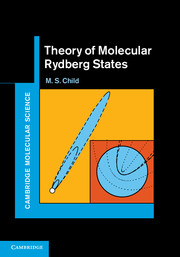Book contents
- Frontmatter
- Contents
- Preface
- 1 Molecular Rydberg states
- 2 The quantum defect picture
- 3 Ab-initio quantum defects
- 4 Frame transformations and channel interactions
- 5 Competitive fragmentation
- 6 Photo-excitation
- 7 Photo-ionization
- 8 Manipulating Rydberg states
- Appendix A MQDT normalization
- Appendix B Alternative MQDT representations
- Appendix C Rotational frame transformations
- Appendix D Optical transition and photo-ionization amplitudes
- Appendix E Generalized MQDT representation
- Appendix F Notation
- Index
- References
1 - Molecular Rydberg states
Published online by Cambridge University Press: 07 October 2011
- Frontmatter
- Contents
- Preface
- 1 Molecular Rydberg states
- 2 The quantum defect picture
- 3 Ab-initio quantum defects
- 4 Frame transformations and channel interactions
- 5 Competitive fragmentation
- 6 Photo-excitation
- 7 Photo-ionization
- 8 Manipulating Rydberg states
- Appendix A MQDT normalization
- Appendix B Alternative MQDT representations
- Appendix C Rotational frame transformations
- Appendix D Optical transition and photo-ionization amplitudes
- Appendix E Generalized MQDT representation
- Appendix F Notation
- Index
- References
Summary
The nature of Rydberg states
The nature of atomic Rydberg states is well described by Gallagher, though with less emphasis on theory [1]. Those of molecules are severely complicated by the additional nuclear degrees of freedom, in a way that gives them quite different properties from those treated in most spectroscopic texts [2, 3, 4, 5]. The essential difference is that established spectroscopic theory is rooted in the Born–Oppenheimer approximation, whereby the frequencies of the electronic motion are assumed to be so high compared with the vibrational and rotational ones that the nuclear motions may be treated as moving under an adiabatic electronic energy (or potential energy) surface. In addition the vibrational frequency usually far exceeds that of the rotations, which means that every vibrational state has an approximate rotational constant. Such considerations provide the basis for a highly successful systematic theory. Modern ab-initio methods allow the calculation of very reliable potential energy surfaces and there are a variety of efficient methods for diagonalizing the resulting Hamiltonian matrix within a functional or numerical basis. Electronically non-adiabatic interactions between a small number of electronic states can also be handled by this matrix diagonalization approach, even including fragmentation processes, if complex absorbing potentials are added to the molecular Hamiltonian.
The difficulty in applying such techniques to highly excited molecular electronic states is that the Rydberg spectrum of every molecule includes 100 electronic states with principal quantum number n = 10, separated from the n = 11 manifold by only 100 cm-1, which is small compared with most vibrational spacings and comparable to rotational spacings for small hydride species.
- Type
- Chapter
- Information
- Theory of Molecular Rydberg States , pp. 1 - 16Publisher: Cambridge University PressPrint publication year: 2011



